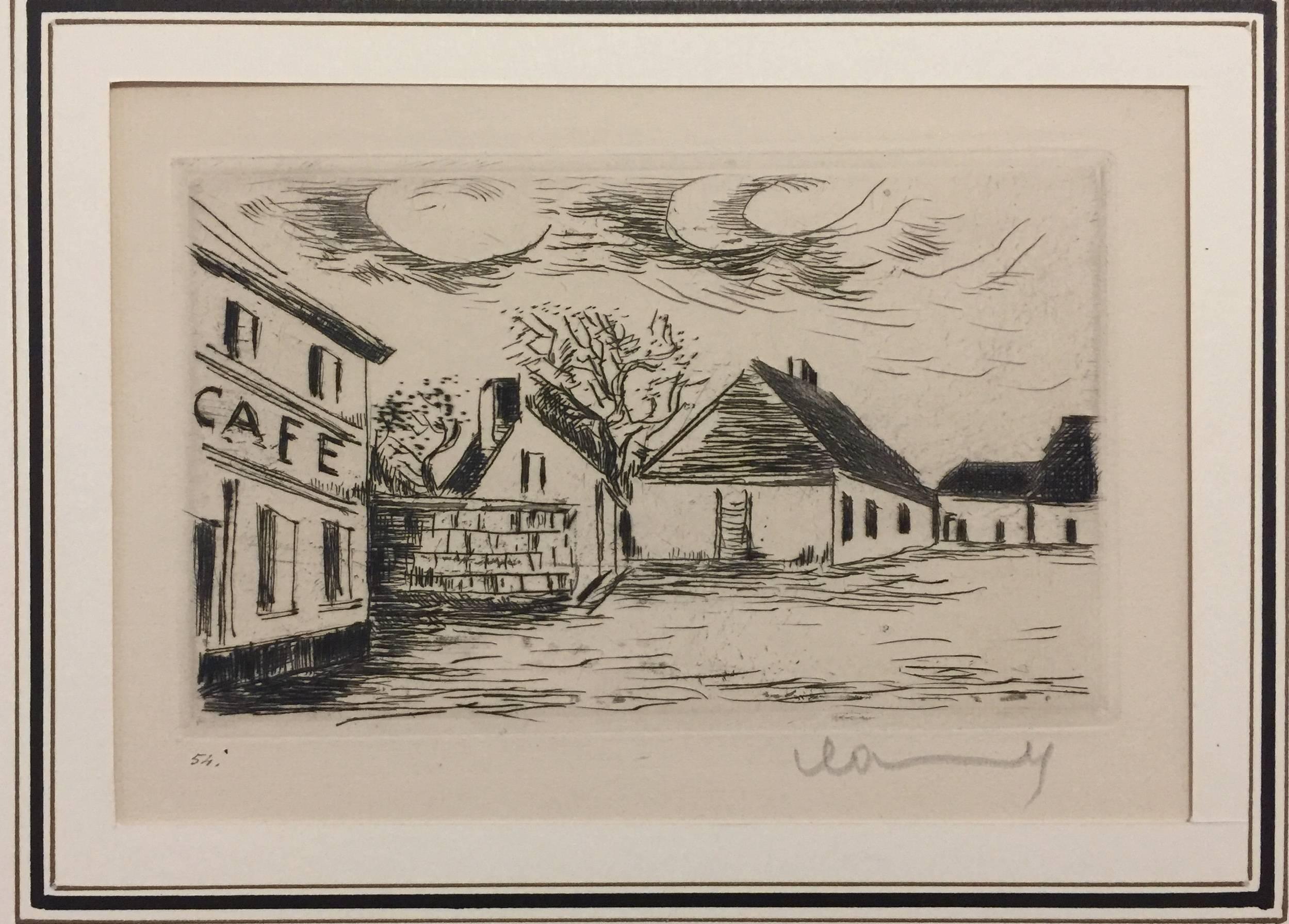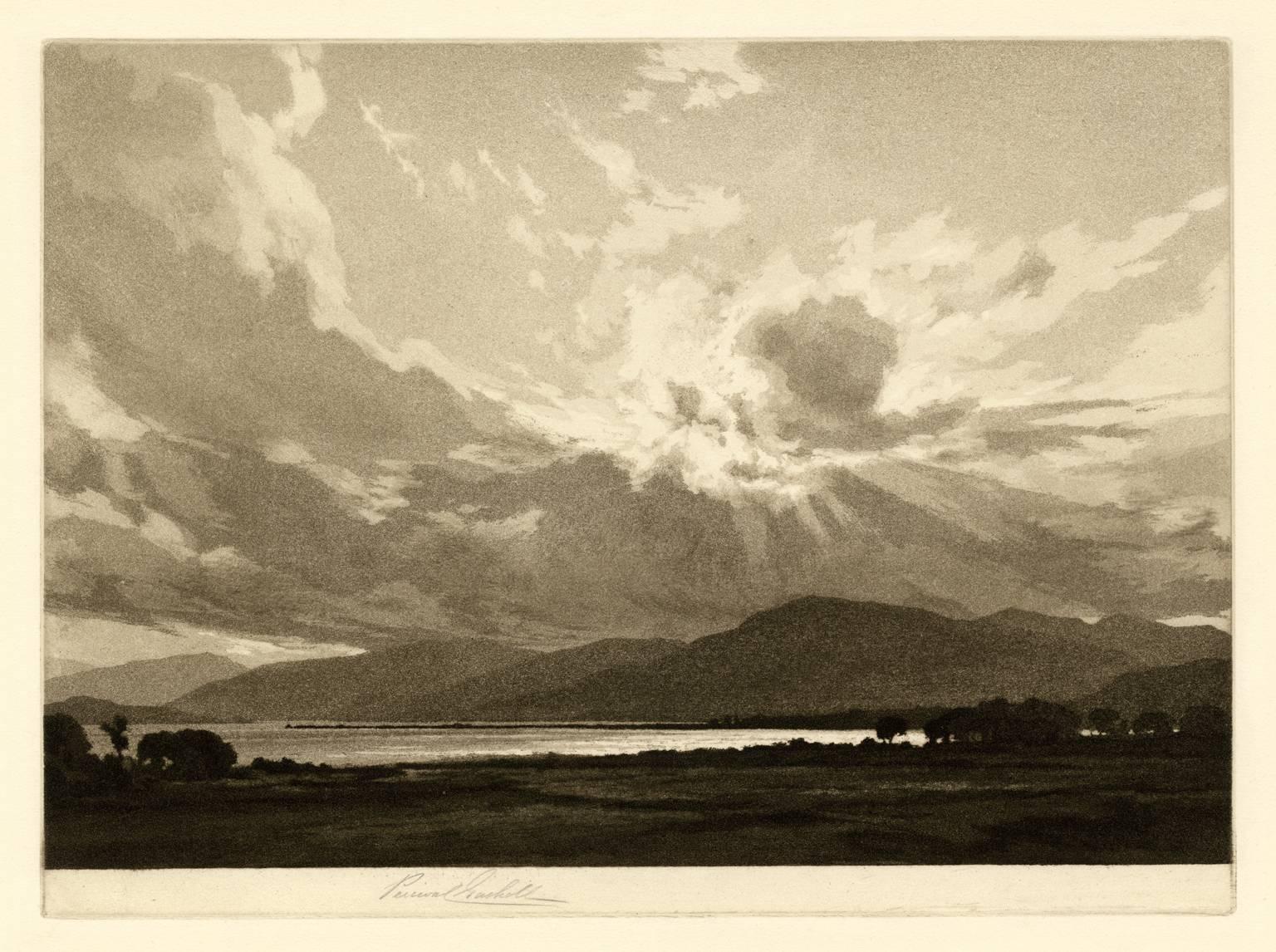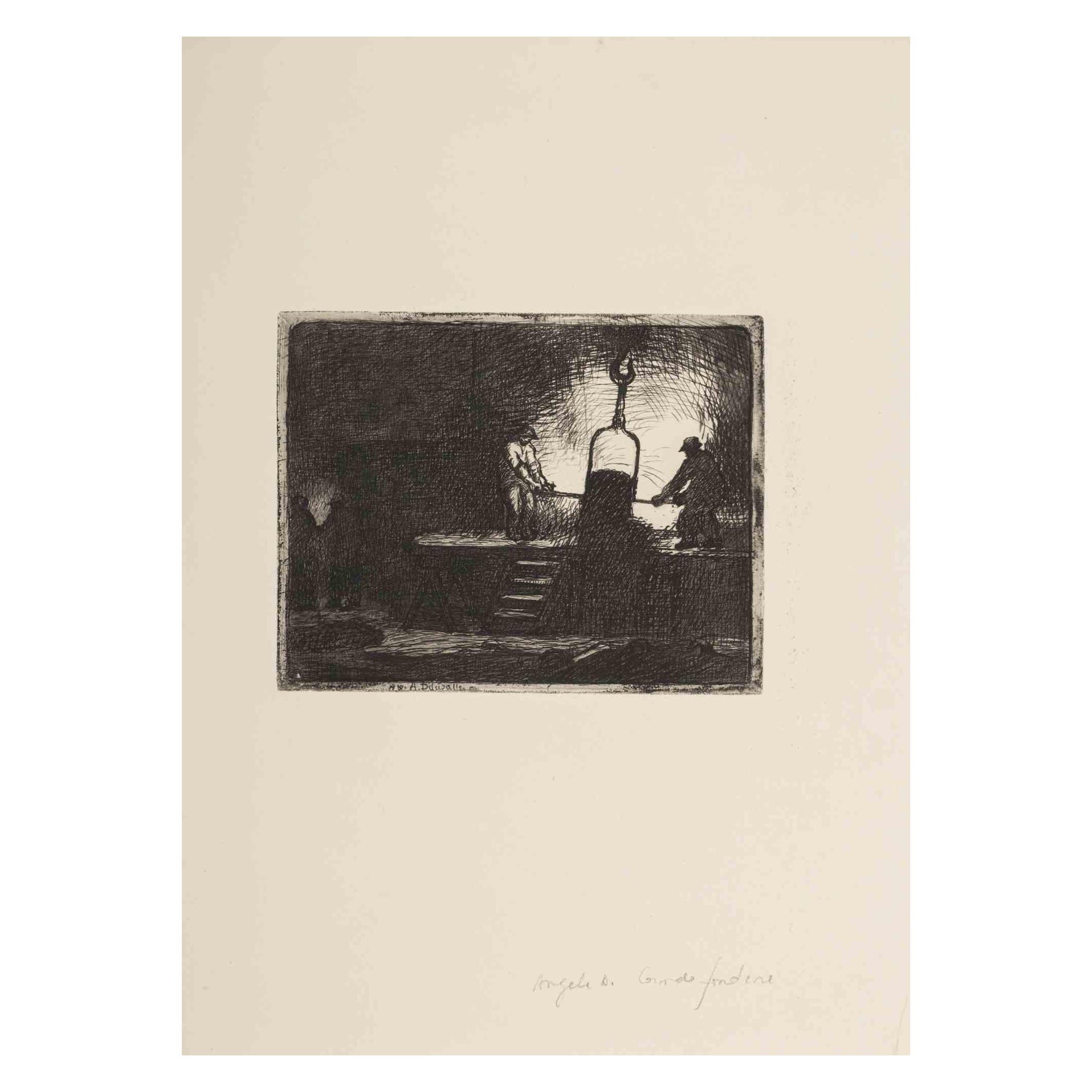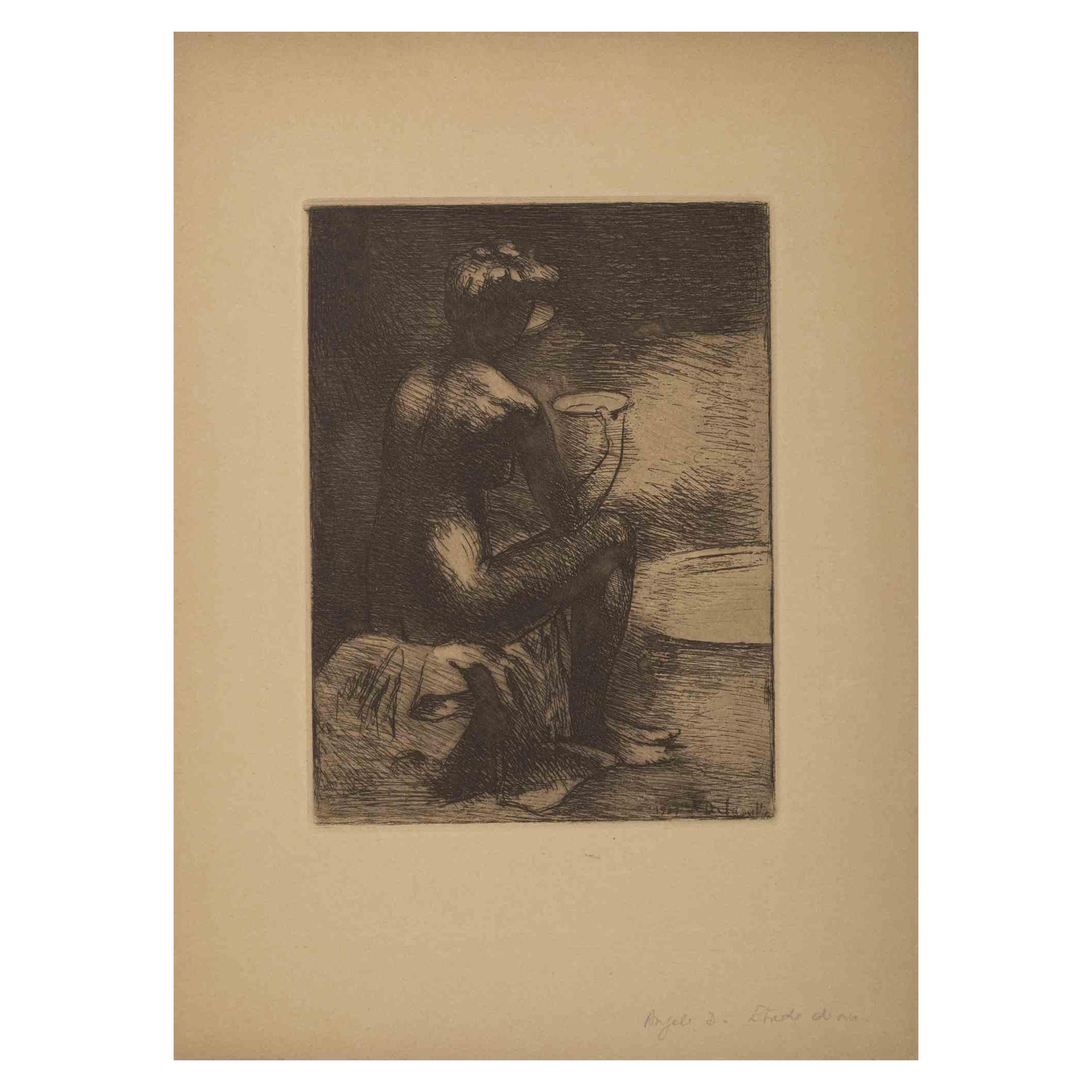Items Similar to Arch of the Pont Neuf, Paris
Want more images or videos?
Request additional images or videos from the seller
1 of 9
Sir Frank BrangwynArch of the Pont Neuf, Paris1923
1923
About the Item
Arch of the Pont Neuf, Paris
Etching on heavy wove paper, 1923
Signed in pencil lower right (see photo)
From: Brangwyn Portfolio (12 original etchings and three lithographs)
Published by E. F. D'Aligan and Paul Turpin, Editeurs, Paris
Edition: 120 (80/120) on title page
Original price: 100 guineas
Reference: Gaunt 282, published edition
Image/plate size: 21 7/8 x 13 3/8 inches
Sheet size: 23 15/16 x 17 5/8 inches
Condition: Excellent
- Creator:Sir Frank Brangwyn (1867-1956, British)
- Creation Year:1923
- Dimensions:Height: 21.875 in (55.57 cm)Width: 13.375 in (33.98 cm)
- Medium:
- Movement & Style:
- Period:
- Condition:
- Gallery Location:Fairlawn, OH
- Reference Number:
About the Seller
5.0
Recognized Seller
These prestigious sellers are industry leaders and represent the highest echelon for item quality and design.
Platinum Seller
These expertly vetted sellers are 1stDibs' most experienced sellers and are rated highest by our customers.
Established in 1978
1stDibs seller since 2013
712 sales on 1stDibs
Typical response time: 1 hour
Associations
International Fine Print Dealers Association
- ShippingRetrieving quote...Ships From: Fairlawn, OH
- Return PolicyA return for this item may be initiated within 10 days of delivery.
More From This SellerView All
- Saint TropezBy André Dunoyer de SegonzacLocated in Fairlawn, OHSaint Tropez Etching with aquatint, printed in colors, 1964 Signed in ink and numbered in pencil Edition: 71/100 Issued for the album St. Tropez et la Provence, in 1966 Reference: Lo...Category
1960s Post-Impressionist Landscape Prints
MaterialsEtching
- Saint-Tropez-Le PortBy Paul SignacLocated in Fairlawn, OHSaint-Tropez-Le Port Color lithograph, 1897-1898 Signed in pencil lower right (see photo) Numbered in pencil lower right: No. 68 (see photo) From: Album des Peintres-Gravures, 1898 Published by Ambrose Vollard, Paris Printer: Auguste Clot, Paris Edition: 100 Numbered: No. 68 Reference: Una Johnson, Vollard, No. 188, reproduced pale 35 Kornfeld & Wick, No. 19 b/b Condition: Very fresh colors One tiny spot in the upper margin above the image (see photo) Image size: 17 1/8 x 13 inches Frame size: 32 3/4 x 27 1/4 inches Archival framing by Galerie Maximilian, Aspen, CO Museum glass 22K Gold leaf hand carved frame...Category
1890s Post-Impressionist Landscape Prints
MaterialsLithograph
- BougivalBy Maurice de VlaminckLocated in Fairlawn, OHBougival Woodcut, 1914 Signed and numbered in pencil Edition 30, this numberd 22 Printed on laid Van Gelder Zonen paper Published by Henri Kanweiler, Paris Printed by Paul Birault, Paris Bougival is located west of Paris, on the left bank of the River Seine. This woodcut was inspired by Vlaminck's 1905 Fauvist masterpiece of the same title in the collection of the Detroit Institute of Art. An impression of this image is in the Yale Univeristy Art Gallery, Condition: Very slight sun staining, otherrwise very good Image/block size: 13 1/4 x 16 1/4 inches Sheet size: 19 1/8 x 22 1/8 inches Reference: Walterskirchen 11b Maurice de Vlaminck (4 April 1876 – 11 October 1958) was a French painter. Along with André Derain and Henri Matisse, he is considered one of the principal figures in the Fauve movement, a group of modern artists who from 1904 to 1908 were united in their use of intense colour.] Vlaminck was one of the Fauves at the controversial Salon d'Automne exhibition of 1905. Life Maurice de Vlaminck was born on Rue Pierre Lescot in Paris. His father Edmond Julien was Flemish and taught violin and his mother Joséphine Caroline Grillet came from Lorraine and taught piano His father taught him to play the violin.[3] He began painting in his late teens. In 1893, he studied with a painter named Henri Rigalon on the Île de Chatou In 1894 he married Suzanne Berly. The turning point in his life was a chance meeting on the train to Paris towards the end of his stint in the army. Vlaminck, then 23 and already active in anarchist circles in Paris, met an aspiring artist, André Derain, with whom he struck up a lifelong friendship.] When Vlaminck completed his army service in 1900, the two rented a studio together, the Maison Levanneur, which now houses the Cneai,[6] for a year before Derain left to do his own military service. In 1902 and 1903 he wrote several mildly pornographic novels illustrated by Derain. He painted during the day and earned his livelihood by giving violin lessons and performing with musical bands at night. Vlaminck participated in the controversial 1905 Salon d'Automne exhibition. After viewing the boldly colored canvases of Vlaminck, Henri Matisse, André Derain, Albert Marquet, Kees van Dongen, Charles Camoin, and Jean Puy, the art critic Louis Vauxcelles disparaged the painters as "fauves" (wild beasts), thus giving their movement the name by which it became known, Fauvism. In 1911, Vlaminck traveled to London and painted by the Thames. In 1913, he painted again with Derain in Marseille and Martigues. In World War I he was stationed in Paris, and began writing poetry. Eventually he settled in Rueil-la-Gadelière, a small village south-west of Paris. He married his second wife, Berthe Combes, with whom he had two daughters. From 1925 he traveled throughout France, but continued to paint primarily along the Seine, near Paris. Resentful that Fauvism had been overtaken by Cubism as an art movement Vlaminck blamed Picasso "for dragging French painting into a wretched dead end and state of confusion". During the Second World War, Vlaminck visited Germany and on his return published a tirade against Picasso and Cubism in the periodical Comoedia in June 1942. Vlaminck wrote many autobiographies. Vlaminck died in Rueil-la-Gadelière on 11 October 1958. Artistic career Two of Vlaminck's groundbreaking paintings, Sur le zinc (At the Bar) and L'homme a la pipe (Man Smoking a Pipe) were painted in 1900. For the next few years Vlaminck lived in or near Chatou (the inspiration for his painting houses at Chatou), painting and exhibiting alongside Derain, Matisse, and other Fauvist painters. At this time his exuberant paint application and vibrant use of colour displayed the influence of Vincent van Gogh. Sur le zinc called to mind the work of Toulouse-Lautrec and his portrayals of prostitutes and solitary drinkers, but does not attempt to probe the sitter's psychology—a break with the century-old European tradition of individualized portraiture. According to art critic Souren Melikian, it is "the impersonal cartoon of a type. In his landscape paintings, his approach was similar. He ignored the details, with the landscape becoming a vehicle through which he could express mood through violent colour and brushwork. An example is Sous bois, painted in 1904. The following year, he began to experiment with "deconstruction," turning the physical world into dabs and streaks of colour that convey a sense of motion. His paintings Le Pont de Chatou (The Chatou Bridge), Les Ramasseurs de pommes de terre (The Potato Pickers...Category
1910s Fauvist Landscape Prints
MaterialsWoodcut
- Barges, DordrechtBy James Abbott McNeill WhistlerLocated in Fairlawn, OHBarges, Dordrecht Etching, c. 1886 Signed in the plate with the butterfly Edition: One of 10 known impressions of this image. VERY RARE Provenance: Frederick Keppel & Co. with their ...Category
19th Century Impressionist Landscape Prints
MaterialsEtching
- A L'Ombre (In Shadow)By Louis LegrandLocated in Fairlawn, OHA L'Ombre (In Shadow) Etching & drypoint, 1905 Signed with the red stamp of the publisher Pellet (see photo) Edition: 50 on velin paper, signed and numbered Publisher: Gustav Pellet, Paris (his red stamp lower right, recto; Lugt 1193) Condition: Excellent Image/Plate size: 5-7/8 x 8-5/8" (14.8 x 21.8 cm.) Sheet size: 11 5/8 x 17 1/8" Reference: IFF 119 Exteens 229 Arwas 256 v/V Louis Auguste Mathieu Legrand (29 September 1863 – 1951) was a French artist, known especially for his aquatint engravings, which were sometimes erotic. He was awarded the Légion d'honneur for his work in 1906. Life Legrand was born in the city of Dijon in the east of France. He worked as a bank clerk before deciding to study art part-time at Dijon's Ecole des Beaux-Arts. He won the Devosge prize at the school in 1883.[2] In 1884 Legrand studied engraving under the Belgian printmaker Félicien Rops. Legrand's artworks include etchings, graphic art and paintings. His paintings featured Parisian social life. Many were of prostitutes, dancers and bar scenes, which featured a sense of eroticism. According to the Hope Gallery, "Louis Legrand is simply one of France's finest early twentieth century masters of etching." His black and white etchings especially provide a sense of decadence; they have been compared to those of Henri de Toulouse-Lautrec, though his drawings of the Moulin Rouge, the can-can dance and the young women of Montmartre preceded Toulouse-Lautrec's paintings of similar scenes. He made over three hundred prints of the night life of Paris. They demonstrate "his remarkable powers of observation and are executed with great skill, delicacy, and an ironic sense of humor that pervades them all." Two of his satirical artworks caused him to be tried for obscenity. The first, "Prostitution" was a symbolic drawing which depicted a naked girl being grasped by a dark monster which had the face of an old woman and claws on its hands; the second, "Naturalism", showed the French novelist Émile Zola minutely studying the thighs of a woman with a magnifying glass. Defended by his friend the lawyer Eugène Rodrigues-Henriques (1853–1928), he was found not guilty in the lower court, but was convicted in the appeal court and then given a short prison sentence for refusing to pay his fine. Legrand was made famous by his colour illustrations for Gil Blas magazine's coverage of the can-can, with text by Rodrigues (who wrote under the pseudonym Erastene Ramiro). It was a tremendous success, with the exceptional quantity of 60,000 copies of the magazine being printed and instantly sold out in 1891. In 1892, at the instigation of the publishing house Dentu, Legrand made a set of etchings of his Gil Blas illustrations. The etchings were published in a book, Le Cours de Danse Fin de Siecle (The End of the Century Dance Classes). Legrand took a holiday in Brittany, which inspired him to engrave a set of fourteen lithographs of simple country life called Au Cap de la Chevre (On Goat Promontory). It was published by Gustave Pellet who became a close friend of Legrand's. Pellet eventually published a total of 300 etchings by Legrand, who was his first artist; he also published Toulouse-Lautrec and Félicien Rops among others. He did not only work in graphics; he exhibited paintings at the Paris salon of the Société Nationale des Beaux-Arts starting in 1902. In 1906 he was made a chevalier of the Légion d'honneur. Legrand died in obscurity in 1951. A retrospective exhibition was held at the Félicien Rops museum in Namur, Belgium in 2006 to celebrate his graphic art. The art collector Victor Arwas published a catalogue raisonné for the occasion. Books illustrated de Maupassant, Guy: Cinq Contes Parisiens, 1905. Poe, Edgar Alan: Quinze Histoires d'Edgar Poe...Category
Early 1900s Art Nouveau Landscape Prints
MaterialsEtching
- Minneapolis at DuskBy Richard HaasLocated in Fairlawn, OHMinneapolis at Dusk Etching & aquatint printed in colors, 1993 Signed, titled and numbered in pencil Edition: 65 (19/65) Condition: Excellent This image depicts the Wells Fargo Center designed by Cesar Pelli Richard Haas (American, b.1936) is a practitioner of the trompe l'oeil artistic style, a technique that uses realistic images in a way that tricks the eye into perceiving the painting in three dimensions. Haas has painted hundreds of murals that incorporate trompe l'oeil methods in the depiction of the architectural features of the building. He was born in Spring Greene but grew up in Milwaukee, WI. He graduated in 1959 from the University of Wisconsin-Milwaukee with a Bachelor in Art. Instructors for his courses included Joseph Friebert (American, 1908–2002) and Robert Von Neuman (German, 1888–1976). Haas returned to his birthplace to work as a helper for his stonemason uncle, and he had an opportunity to view the work of the architect Frank Lloyd Wright (American, 1867–1959). He spent several years as an assistant professor at the University of Michigan before he moved to New York City in 1968. Haas spent 10 years teaching at Vermont's Bennington College, splitting his time between the school and New York. Haas worked for many years as an Abstract painter who used traditional canvas media. He later developed an interest in drawing and etching the details of late 19th century and early 20th century New York City buildings. The artist’s first outdoor mural, a commission to paint the cast iron façade at the corner of Prince Street and Greene Street, was completed in 1975. His other notable murals include Fort Worth, Texas' Homage to Chisholm Trail...Category
1990s Photorealist Landscape Prints
MaterialsEtching
You May Also Like
- Pavillon dans les Arbres (Pavilion in the Trees) /// Impressionist Henri SidanerBy Henri Le SidanerLocated in Saint Augustine, FLArtist: Henri Le Sidaner (French, 1862-1939) Title: "Pavillon dans les Arbres (Pavilion in the Trees)" Portfolio: Henri Le Sidaner (Camille Mauclair) *Issued unsigned, though signed by Sidaner in the plate (printed signature) lower left Year: 1928 Medium: Original Etching on Rives BFK paper Limited edition: Unknown Printer: Unknown Publisher: Galeries Georges Petit and Henri Floury, Paris, France Reference: Bibliothèque Nationale No. 12 Sheet size: 11" x 8.38" Image size: 9.25" x 7.13" Condition: Some minor foxing on verso. It is otherwise a strong impression in excellent condition Notes: Printed in one color: bistre. Comes from Camille Mauclair's 1928 book publication "Henri Le Sidaner" which contained two bound original drypoint etchings by Sidaner. Comes with its original tissue cover...Category
1920s Post-Impressionist Landscape Prints
MaterialsIntaglio, Drypoint, Etching
- Au Bois de Boulogne - Original Etching by H. Farge - Mid 20th CenturyLocated in Roma, ITImage dimensions: 16 x 11 cm. Au Bois de Boulogne is an original modern artwork realized in the first decades of the XX Century by the French artist Henri Farge...Category
Mid-20th Century Post-Impressionist Figurative Prints
MaterialsEtching
- Cafè de ParisBy Maurice de VlaminckLocated in Roma, ITOriginal drypoint and etching. Hand signed. From the suite: "Visage de Maisons". Image Dimensions : 17 x 11 cm This artwork is shipped from Italy. Under existing legislation, any a...Category
1920s Post-Impressionist Landscape Prints
MaterialsEtching
- Sunset - ArdgourBy Percival GaskellLocated in Myrtle Beach, SCPercival Gaskell, 'Sunset - Ardgour", aquatint, edition not stated, c. 1920. A superb, atmospheric impression, in brown/black ink, on cream wove paper; the full sheet with margins (2 to 3 inches), in excellent condition. Signed, titled, and numbered '2' in pencil. Matted to museum standards, unframed. Ardgour is a district of Lochaber on Ardnamurchan peninsula on the western shore of Loch Linnhe...Category
1920s Post-Impressionist Landscape Prints
MaterialsAquatint
- Working - Original Etching by A. Delasalle - Mid-20th CenturyBy Angèle DelasalleLocated in Roma, ITWorking is a contemporary artwork realized by the French artist Angèle Delasalle in the Mid-20th Century. Original etching and drypoint. Signed and ...Category
Mid-20th Century Post-Impressionist Figurative Prints
MaterialsEtching
- Study for a Nude - Original Etching by A. Delasalle - Mid-20th CenturyBy Angèle DelasalleLocated in Roma, ITStudy for a Nude is a contemporary artwork realized by the French artist Angèle Delasalle in the Mid-20th Century. Original etching and drypoint. Si...Category
Mid-20th Century Post-Impressionist Figurative Prints
MaterialsEtching
Recently Viewed
View AllMore Ways To Browse
Pont Neuf
Pont Neuf Paris
Roy Lichtenstein Sunrise
Shokler Harry
Salvador Dali The Alps
Robert Bennett On Sale
Teatro Museo Figueras
Twa Poster Rome
Hall Thorpe Woodcut
Peter Max Boat
Massimo Vitali On Sale
Shepard Fairey Big Brother
Sweetgrass Carriers
Raquettes Vintage
Raquette Vintage
Jim Buckels On Sale
Michael Graves Target
Lila Hunter





